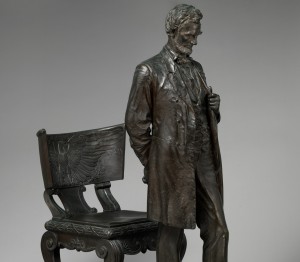Abe Lincoln Comes Home To New York City
For Richard C. McCormick, a journalist at the New York Evening Post, reporting in his “Intimate Memories of Lincoln” piece of May 3, 1965, Lincoln’s appearance on the day of his speech left much to be desired. Arriving with several members of the Young Men’s Republican Union, he found Lincoln in a black suit, “much wrinkled from its careless packing in a small valise.” The senator was cordial enough, but apologized for the awkward and uncomfortable appearance he made. “His form and manner were indeed very odd, and we thought him the most unprepossessing public man we had ever met,” McCormick embellished.
During his photo session, Lincoln confessed to McCormick he was simply “on his way to New Hampshire where he had a son in college, who, if report were true, already knew much more than his father.” The son Lincoln refers to was Robert Todd Lincoln, the eldest of his four sons, and the only one to survive to adulthood.
A little farther afield, in the town of Manchester, Vermont, Robert Todd Lincoln’s summer estate, Hildene, is open to visitors. Gary Sloan, a friendly and forthcoming tour guide there, explained that Robert used to tease his acquaintances by saying that he was accountable for his father becoming President, “I take full responsibility for my father becoming President, because it was his desire to see his son that made him go to Cooper Union to give his speech en route to seeing me.”
In retrospect, this may sound a little tongue in cheek. But there’s no denying that Lincoln’s propitious appearance at Cooper Union that night changed the course of history.
The eccentric philanthropist, Peter Cooper, had established his school only the year before, with no color bar and left open to women as well as men. In spite of heavy snow, 1,500 people were in attendance to hear what later became known as the “right makes might” speech. The New York Times subsequently carried it on the front page. Though New York City was a Democratic stronghold, the state’s 35 electoral votes ensured his victory.
Harold Holzer, one of the country’s foremost scholars on Lincoln, sees the address as “three speeches in one.” It stands as a historical account of slavery; a comment on the South and their need to be more open to negotiation on the issue; and a rallying cry to the people, not to be dissuaded by the difficulty of the task.
A few blocks south of Cooper Union on East Seventh Street, another kind of debate continues. After the speech, did Peter Cooper and Lincoln stroll into the famed McSorley’s pub for a pint? According to bartender Joe McKiernan, it was the closest place at the time “that wasn’t a flophouse.”
While Lincoln was busy making history, his wife, Mary, had other plans. She was an inveterate shopper, according to Mr. Holzer. At A.T. Stewart’s, the Bloomingdale’s of the day, she bought furs, silks, laces, jewelry, and spent as much as $5,000 for a shawl.
Her seamstress, Elizabeth Keckley, later explained her spending as a simple case of the nerves, “Mrs. Lincoln was extremely anxious that her husband should be re-elected President,” she proclaimed. The First Lady told Mrs. Keckley that “he is so sincere and straightforward himself, that he is shocked by the duplicity of others.” As for Lincoln, he was, Mr. Holzer stated, more concerned about Mary’s lingering longingly over the ships in port, dreaming about distant shores.
When Lincoln returned to Cooper Union in 1861 en route to his first inaugural, his popularity was hardly assured. Battles waged at the ballot box. Holzer describes American poet Walt Whitman’s glimpse of Lincoln emerging from his carriage. Watching as Lincoln strode into the Astor Hotel, he commented that “there was no cheering at all.” Whitman felt it was lucky that the President wasn’t shot on the spot.
Lincoln’s presence in New York, even when he wasn’t actually there, could be palpable.
On New Year’s Eve, 1962, in anticipation of the President’s Emancipation Proclamation, 12,000 black New Yorkers prayed and sang hymns. Following the assassination on April 24-25, 1865, 200 African Americans took up the rear flank, filing by the casket lying in state at City Hall. Their banner read: “ABRAHAM LINCOLN, our Emancipator. Two Millions of Bondmen he Liberty gave.” Holzer emphasized in spite of New Yorkers’ opposition, the ban against the black marchers was overturned by the Secretary of War.
Lincoln at the New York Historical Society
Just across Central Park, the New York Historical Society is paying homage to Lincoln in its own stately fashion. They have given both Lincoln and the great Black abolitionist, Frederick Douglass, an impressive physical presence: two bronze statues on the exterior entrance stairways, created by StudioEIS in Brooklyn. They hope the statues will “entice young people to learn more about how two figures, born outside of our city, like so many others today, were actually made in New York.”
My friendly guide, at Robert Todd Lincoln’s Hildene home, summed it up best, “We can all relate to the story of someone from such humble beginnings and no matter where in the world you call home, and no matter when in history you read that story, it can resonate to you. He was by far one of the most relatable people in history, going from so little to such greatness.”
If home is where the heart is, for many New Yorkers, Lincoln has come home.


